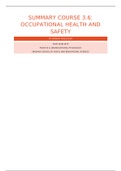SUMMARY COURSE 3.6:
OCCUPATIONAL HEALTH AND
SAFETY
BY ROWAN MOELIJKER
YEAR 2018/2019
POSITIVE & ORGANIZATIONAL PSYCHOLOGY
ERASMUS SCHOOL OF SOCIAL AND BEHAVIOURAL SCIENCES
,PROBLEM 3: WORK HOURS, FATIGUE, AND RECOVERY
OVERTIME AND WORK SCHEDULES
BECKERS, D.G.J., VAN DER LINDEN, D., SMULDERS, P.G.W., KOMPIER, M.A.J., TARIS, T. W., &
GEURTS, S. A. E. (2008). VOLUNTARY OR INVOLUNTARY? CONTROL OVER OVERTIME AND
REWARDS FOR OVERTIME IN RELATION TO FATIGUE AND WORK SATISFACTION. WORK &
STRESS, 22(1), 33–50. DOI:10.1080/02678370801984927
Professor notes: This is an empirical study on overtime work in relationship to fatigue and satisfaction. It takes
into account two essential variables, whether overtime is voluntary or not, and whether overtime is sufficiently
rewarded or not. Get some knowledge about why these variables are important and what theoretical models
underlie them. Also, know the results and what they mean (how to interpret them).
Effort-Recovery Theory: overtime work implies that effort investment is prolonged and recovery time is
reduced. Accordingly, overtime work can lead to a situation of prolonged insufficient recovery that is assumed
to disturb physiological processes and, as a consequence, induce health problems.
Adverse Behaviour Theory: according to a second mechanism, overtime work has been linked to adverse
behaviour and habits such as an unhealthy diet, lack of exercise, and smoking, which in turn may cause health
problems.
In the Netherlands overtime hours vary from low to extreme, but it has been estimated that the average Dutch
employee works 3 to 4 overtime hours a week. Particularly for such moderate overtime work, the association
with health and well-being does not seem to be simple and straightforward, but seems to depend on the
psychosocial profile of the overtime job. Psychosocial task characteristics such as job demands, job variety, and
job control are certainly among such moderating factors that determine whether overtime work is associated
with adverse effects.
From work time and work motivation literature, two other psychosocial work characteristics emerge that may
act as moderators in the overtime-health association, namely
(1) control over overtime work.
(2) rewards for overtime work.
Worktime control: an employee’s possibilities of control over the duration, position, and distribution of
worktime.
In the current study, the authors investigate whether a specific facet of worktime control, namely control over
overtime work, plays a comparable role in the relationship between overtime work and well-being.
Schematically, they distinguish between two opposite poles of overtime control, namely voluntary overtime
work (signifying high overtime control) and involuntary overtime work (signifying low overtime control).
Hypothesis: Voluntary overtime is associated with positive indicators of health and well-being (low fatigue and
high work satisfaction), and involuntary overtime is related to adverse health and well-being (high fatigue and
low work satisfaction).
Effort Reward-Imbalance (ERI) Model: employees’ efforts at work are part of a social exchange process in
which employees expect fair rewards or compensation for their invested efforts. It is assumed that a lack of
reciprocity between efforts and rewards (i.e., high effort investment that is not compensated by rewards) may
elicit distress and low satisfaction.
Hypothesis: Overtime work is mainly associated with adverse well-being when employees receive no rewards
for their extra work hours.
, Method
Data were collected in 2004 as part of a large questionnaire study on the work situation and well-being of
Dutch employees.
Results
Prevalence: the majority of this heterogeneous and largely representative Dutch sample reported working
overtime (69.8%, i.e., 1612 overtime workers). Most of these overtime workers reported to work moderate
overtime, with an average of 7.5 overtime hours a week, and 80% working less than 10 weekly overtime hours.
Compared to involuntary overtime workers, voluntary overtime workers had higher educational levels, higher
income, and more job variety and job autonomy. In a similar vein, when compared to rewarded overtime
workers, unrewarded overtime workers also scored higher on all these job and personal characteristics.
Moreover, the unrewarded group also reported more overtime hours and job demands. It can thus be
concluded that voluntary and unrewarded overtime workers generally work in more favourable jobs with a
relatively high income and a good combination of work characteristics.
For wellbeing it did matter whether employees worked overtime voluntarily or involuntarily, and whether they
were rewarded or not. In general, involuntary overtime work was associated with relatively high fatigue and
low satisfaction. This was particularly true for involuntary overtime workers who were not rewarded for their
extra efforts. This specific group of overtime workers can be considered a ‘‘burnout risk group’’ as their
average fatigue scores can be classified as ‘‘high’’ according to validated burnout norm.
Conversely, voluntary overtime workers were relatively non-fatigued and satisfied even when they received no
rewards for their extra work hours. These group differences could not be explained by any differences in work
characteristics or personal characteristics.
Possible explanations (speculations)
The authors speculate that the higher well-being of the voluntary overtime workers might at least partly be
explained by the congruence between their actual and desired work hours, as their overtime work is self-
chosen. For involuntary overtime workers, on the other hand, there seems to be a mismatch between actual
and desired work hours. In case of such a mismatch, the imposed additional work hours can be considered to
induce extra costs to the employee. Both the Effort-Reward Imbalance Model and Effort-Recovery Theory posit
that such costs may lead to negative consequences for health and well-being.
Limitations
1. The study did not factually ask respondents if they worked overtime voluntarily, involuntarily, or both. Six
possible reasons for overtime work were included in this study, of which only three gave valid insight into the
(in)voluntary nature of overtime work. As not all reasons for overtime work fitted the topic of this study, ‘‘only’’
half of the respondents (n=814) could be categorized as a typical voluntary, involuntary, or partly
voluntary/partly involuntary overtime worker.
2. The variables were studied through self-reports.





